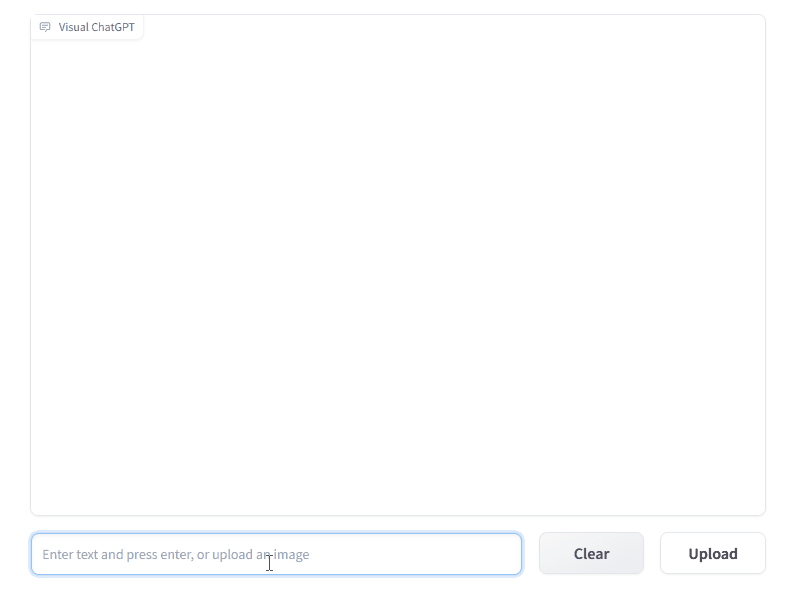Visual ChatGPT connects ChatGPT and a series of Visual Foundation Models to enable sending and receiving images during chatting.
See our paper: Visual ChatGPT: Talking, Drawing and Editing with Visual Foundation Models

- Add custom GPU/CPU assignment
- Add windows support
- Merge HuggingFace ControlNet, Remove download.sh
- Add Prompt Decorator
- Add HuggingFace and Colab Demo
- Clean Requirements
One the one hand, ChatGPT (or LLMs) serves as a general interface that provides a broad and diverse understanding of a wide range of topics. On the other hand, Foundation Models serve as domain experts by providing deep knowledge in specific domains. By leveraging both general and deep knowledge, we aim at building an AI that is capable of handling a various of tasks.
# clone the repo
git clone https://github.com/microsoft/visual-chatgpt.git
# Go to directory
cd visual-chatgpt
# create a new environment
conda create -n visgpt python=3.8
# activate the new environment
conda activate visgpt
# prepare the basic environments
pip install -r requirements.txt
# prepare your private OpenAI key (for Linux)
export OPENAI_API_KEY={Your_Private_Openai_Key}
# prepare your private OpenAI key (for Windows)
set OPENAI_API_KEY={Your_Private_Openai_Key}
# Start Visual ChatGPT !
# You can specify the GPU/CPU assignment by "--load", the parameter indicates which
# Visual Foundation Model to use and where it will be loaded to
# The model and device are sperated by underline '_', the different models are seperated by comma ','
# The available Visual Foundation Models can be found in the following table
# For example, if you want to load ImageCaptioning to cpu and Text2Image to cuda:0
# You can use: "ImageCaptioning_cpu,Text2Image_cuda:0"
# Advice for CPU Users
python visual_chatgpt.py --load ImageCaptioning_cpu,Text2Image_cpu
# Advice for 1 Tesla T4 15GB (Google Colab)
python visual_chatgpt.py --load "ImageCaptioning_cuda:0,Text2Image_cuda:0"
# Advice for 4 Tesla V100 32GB
python visual_chatgpt.py --load "ImageCaptioning_cuda:0,ImageEditing_cuda:0,
Text2Image_cuda:1,Image2Canny_cpu,CannyText2Image_cuda:1,
Image2Depth_cpu,DepthText2Image_cuda:1,VisualQuestionAnswering_cuda:2,
InstructPix2Pix_cuda:2,Image2Scribble_cpu,ScribbleText2Image_cuda:2,
Image2Seg_cpu,SegText2Image_cuda:2,Image2Pose_cpu,PoseText2Image_cuda:2,
Image2Hed_cpu,HedText2Image_cuda:3,Image2Normal_cpu,
NormalText2Image_cuda:3,Image2Line_cpu,LineText2Image_cuda:3"
Here we list the GPU memory usage of each visual foundation model, you can specify which one you like:
| Foundation Model | GPU Memory (MB) |
|---|---|
| ImageEditing | 3981 |
| InstructPix2Pix | 2827 |
| Text2Image | 3385 |
| ImageCaptioning | 1209 |
| Image2Canny | 0 |
| CannyText2Image | 3531 |
| Image2Line | 0 |
| LineText2Image | 3529 |
| Image2Hed | 0 |
| HedText2Image | 3529 |
| Image2Scribble | 0 |
| ScribbleText2Image | 3531 |
| Image2Pose | 0 |
| PoseText2Image | 3529 |
| Image2Seg | 919 |
| SegText2Image | 3529 |
| Image2Depth | 0 |
| DepthText2Image | 3531 |
| Image2Normal | 0 |
| NormalText2Image | 3529 |
| VisualQuestionAnswering | 1495 |
We appreciate the open source of the following projects:
Hugging Face LangChain Stable Diffusion ControlNet InstructPix2Pix CLIPSeg BLIP
For help or issues using the Visual ChatGPT, please submit a GitHub issue.
For other communications, please contact Chenfei WU (chewu@microsoft.com) or Nan DUAN (nanduan@microsoft.com).

